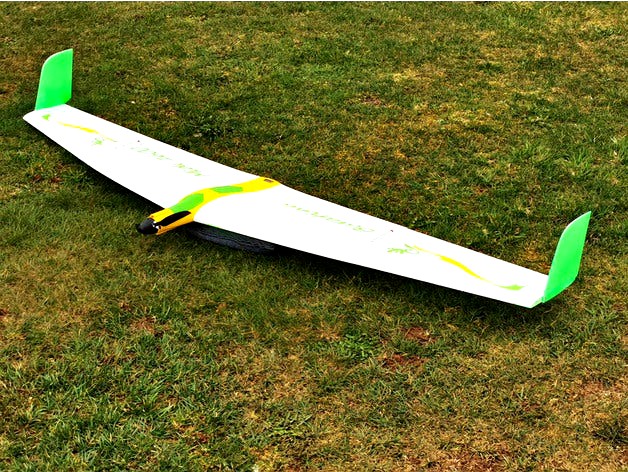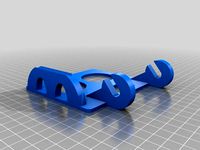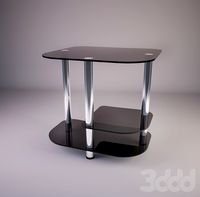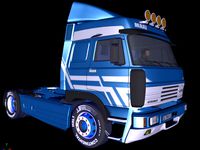Thingiverse

Buratinu Maxi 1600 by wersy
by Thingiverse
Last crawled date: 3 years ago
After Hans-Juergen tested the Buratinu 1300 I designed middle wing parts to expand the wingspan to 1600 mm.
Many thanks again Hans-Juergen, for printing and testing it for me!
This is way the Buratinu 1600 version was born ;)
https://youtu.be/ne5Z_o-d_dA
This is his detailed report
-START-
Weather conditions during testing:
Morning from 10 am, temperature about 6-8 degrees, cloudless sky, weak wind from NW with maximum 5 km/h and negligible thermals.
The results are quite interesting, but in the end had almost been expected.
The (safe) center of gravity is actually 190 mm measured from the end of the fuselage. I had to add 20 grams of lead at the height of the front cover under the fuselage to keep the center of gravity because of additionally installed cables and telemetry sensors. The takeoff weight is thus 870 grams, the wing loading about 26 g/sqm.
I changed the motor and mounted an Extron 2217/16 (KV 1140, 28 mm diameter and 33 mm length) on a 9" x 6" folding propeller. It draws 22 amps on the 3S/1000 battery when stationary. This makes for an exceptionally good motorization.
The elevator is set to about 3 mm depth (measured on the outside of the rudder to the wing) at neutral stick position. This is absolutely necessary, otherwise the Buratinu-1600 will rise mercilessly when the elevator is in neutral position.
Furthermore, add about 15% depth for the motor in proportion to the motor power. With these settings and a good amount of Expo (50%) on all rudders, the Buratinu shows a very balanced flight behavior.
Hand launching is absolutely no problem with a little push from the hand. I was really surprised by the "creep ride" of the Buratinu.
I tried to "starve" it several times in glide to see the behavior during stall. I had to wait a long time and then it merely took the nose down slightly to pick up speed.The 1600 is a comfortable flyer with good ambitions for a relaxed flight in thermals. But I'm sure that will be fleshed out in the next few flights. I have flown the GPS logger with pressure sensor and TEC probe (the small rod on the back of the fuselage) on a trial basis to test whether the data is sufficient for measurements in the future.
I also made a small video of one of the flights - the weather was perfect for that. But since the Buratinu often moved at an altitude of about 80 to 100 meters, I had to cut away a lot, because only the blue sky was visible on the pictures. But I think the video still clearly shows where the strengths of this thermal glider is.
The picture below shows the course of the flight after which the glide phases are to be analyzed.
If you want to have a look at it from all sides in Google Earth, here is the link to the kmz:https://my.hidrive.com/share/l9qq-eq951#$/
-END-
All other needed parts can be downloaded from Buratinu 1000
The special thing about this version also is that all parts of the wing, i.e. W3 to W5 as well as the elevons are identical to the original Buratinu version which are included here:https://www.thingiverse.com/thing:3047415
The wingend W6 is smaller. You must take it from the Buratinu Midi 1000https://www.thingiverse.com/thing:4280142
Or in case you can print larger, you can take the parts from here:https://www.thingiverse.com/thing:3857570
The Buratinu 1300 uses the same fuselage as the Buratinu Midi.
So you have to take it from here:https://www.thingiverse.com/thing:4280142
Specifications
airfoils: own design
wing span: 1600 mm
wing chord: 284/140 mm
CoG: 190 mm from rear edge of the fuselage
overall weight: 870 g (PETG/LW PLA)
wing area: 35 dm²
wing loading: 25 g/dm²
motor: Extron 2217/16 1140 KV max 250W
folded propeller: 9 x 6"
battery: 1000 mAh 3S 30C
motor camber: -4°
Print Settings
Wings
perimeter_extrusion_width = 0.5
layer_height = 0.25
perimeters = 1
fill_density = 0%
bottom_solid_layers = 4
top_solid_layers = 4
Many thanks again Hans-Juergen, for printing and testing it for me!
This is way the Buratinu 1600 version was born ;)
https://youtu.be/ne5Z_o-d_dA
This is his detailed report
-START-
Weather conditions during testing:
Morning from 10 am, temperature about 6-8 degrees, cloudless sky, weak wind from NW with maximum 5 km/h and negligible thermals.
The results are quite interesting, but in the end had almost been expected.
The (safe) center of gravity is actually 190 mm measured from the end of the fuselage. I had to add 20 grams of lead at the height of the front cover under the fuselage to keep the center of gravity because of additionally installed cables and telemetry sensors. The takeoff weight is thus 870 grams, the wing loading about 26 g/sqm.
I changed the motor and mounted an Extron 2217/16 (KV 1140, 28 mm diameter and 33 mm length) on a 9" x 6" folding propeller. It draws 22 amps on the 3S/1000 battery when stationary. This makes for an exceptionally good motorization.
The elevator is set to about 3 mm depth (measured on the outside of the rudder to the wing) at neutral stick position. This is absolutely necessary, otherwise the Buratinu-1600 will rise mercilessly when the elevator is in neutral position.
Furthermore, add about 15% depth for the motor in proportion to the motor power. With these settings and a good amount of Expo (50%) on all rudders, the Buratinu shows a very balanced flight behavior.
Hand launching is absolutely no problem with a little push from the hand. I was really surprised by the "creep ride" of the Buratinu.
I tried to "starve" it several times in glide to see the behavior during stall. I had to wait a long time and then it merely took the nose down slightly to pick up speed.The 1600 is a comfortable flyer with good ambitions for a relaxed flight in thermals. But I'm sure that will be fleshed out in the next few flights. I have flown the GPS logger with pressure sensor and TEC probe (the small rod on the back of the fuselage) on a trial basis to test whether the data is sufficient for measurements in the future.
I also made a small video of one of the flights - the weather was perfect for that. But since the Buratinu often moved at an altitude of about 80 to 100 meters, I had to cut away a lot, because only the blue sky was visible on the pictures. But I think the video still clearly shows where the strengths of this thermal glider is.
The picture below shows the course of the flight after which the glide phases are to be analyzed.
If you want to have a look at it from all sides in Google Earth, here is the link to the kmz:https://my.hidrive.com/share/l9qq-eq951#$/
-END-
All other needed parts can be downloaded from Buratinu 1000
The special thing about this version also is that all parts of the wing, i.e. W3 to W5 as well as the elevons are identical to the original Buratinu version which are included here:https://www.thingiverse.com/thing:3047415
The wingend W6 is smaller. You must take it from the Buratinu Midi 1000https://www.thingiverse.com/thing:4280142
Or in case you can print larger, you can take the parts from here:https://www.thingiverse.com/thing:3857570
The Buratinu 1300 uses the same fuselage as the Buratinu Midi.
So you have to take it from here:https://www.thingiverse.com/thing:4280142
Specifications
airfoils: own design
wing span: 1600 mm
wing chord: 284/140 mm
CoG: 190 mm from rear edge of the fuselage
overall weight: 870 g (PETG/LW PLA)
wing area: 35 dm²
wing loading: 25 g/dm²
motor: Extron 2217/16 1140 KV max 250W
folded propeller: 9 x 6"
battery: 1000 mAh 3S 30C
motor camber: -4°
Print Settings
Wings
perimeter_extrusion_width = 0.5
layer_height = 0.25
perimeters = 1
fill_density = 0%
bottom_solid_layers = 4
top_solid_layers = 4
Similar models
thingiverse
free

Buratinu Midi 13000 by wersy
...perimeter_extrusion_width = 0.5
layer_height = 0.25
perimeters = 1
fill_density = 0%
bottom_solid_layers = 4
top_solid_layers = 4
thingiverse
free

Buratinu Maxi 2000 by wersy
...ng the construction of the 2000 (half-shell, skid reinforcement, extended fuselage) and the many helpful suggestions - thank you!
thingiverse
free

Wilde Hummel (short fuselage) by wersy
...g is now at 397 mm from the front of the fuselage.
all other parts and the print settings are indentical with the original plane.
thingiverse
free

Mini Hummel by wersy
... 28-36 1200kv
propeller: aeronaut cam aeronaut carbon classic 9 x 6.5"
battery: turnigy 1600 mah 4s
motor camber: tilted -2°
thingiverse
free

fuselage, fins and motor mount for TZAGI flying wing by cyrus
...ly, but it's ok, as you can see from the pictures.
here the maiden flight, shot from a mavic quadhttps://youtu.be/zyyjagz1ecm
thingiverse
free

Little demoness by Marusya
...
thingiverse
shortened the hair to not interfere with the wings. wings from here:https://www.thingiverse.com/thing:481437/#files
thingiverse
free

Motor tower- Bird of Time or other gliders by Kyrill
... in best position before printing.
use ca-glue and activator spray to put parts together.
sand a little if surfaces are not flat.
thingiverse
free

Speedy "Red Midi Swept Wing" by wersy
...0 mah 3s 40~50c lipo
motor camber: tilted -4 degrees
side pull: none
propeller: aeronaut cam aeronaut carbon classic 10 x 6"
thingiverse
free

Bed Support Double Y Wing by VMaxx
...ttp://www.thingiverse.com/thing:1683111
the blender file includes the parts i used to adjust the original for size and alignment.
grabcad
free

Stable horizontal stabilizer
... see the variation of its behavior, granting different missions to each wing, the project is called "triple wing shape"
Buratinu
thingiverse
free

Buratinu Midi 13000 by wersy
...perimeter_extrusion_width = 0.5
layer_height = 0.25
perimeters = 1
fill_density = 0%
bottom_solid_layers = 4
top_solid_layers = 4
thingiverse
free

Buratinu Maxi 2000 by wersy
...ng the construction of the 2000 (half-shell, skid reinforcement, extended fuselage) and the many helpful suggestions - thank you!
thingiverse
free

Mini Buratinu LW PLA by wersy
...m for this if the rear tubes are shortened. therefore i upload a remix of the modified rear fuselage.
fuselage rear 860 lwpla.stl
thingiverse
free

Flying Wing Buratinu by wersy
...ve designed a special fuselage nose.
fuselage 1 rear-mounted mc3
firewall rear-mounted
it has already integrated 3° motor camber.
Wersy
thingiverse
free

Fan 80 mm.stl by wersy
...fan 80 mm.stl by wersy
thingiverse
just a fan 80 mm for your planning.
thingiverse
free

LED Ring Mount for Printrbot by wersy
...led ring mount for printrbot by wersy
thingiverse
this mount can be fastened on one side of the extruder.
thingiverse
free

Penholder Tubes by wersy
...one for the kids with some more tubes.
it is by far not so artfully because i am just an engineer - though i hope you like it :-)
blendswap
free

WERSI Galaxis
...ocal z direction, the lights will switch on or of. for moving the hole organ there is a squared empty.
have fun with this peace.
thingiverse
free

Carrier to carry the Printrbot by wersy
...ty small and not so heavy it is a bit cumbersome to transport because the only stiff parts are the bases connected with the rods.
thingiverse
free

Prusa I2 holder for wersy's case for RRD full graphic LCD by byteborg
...i like the rrd smart lcd and have it integrated in wersy's case. i needed a way to mount it on my prusa i2, so here it is :)
thingiverse
free

Mount for the Full Graphic Smart LCD Controller Case by wersy 2020 3030
...ing for wersy's case holes... so i designed this mount parts for this great lcd case https://www.thingiverse.com/thing:87250.
thingiverse
free

Turbo Car RC (experimental) by wersy
...be/6tzpffwsd0q
tires:http://www.makeblock.com/tire-68-5x22mm-4-packhttps://www.kiwi-electronics.nl/band-68-5x22mm-4-stuks?lang=de
thingiverse
free

Case for the Full Graphic Smart LCD Controller by wersy
...is a case for the full graphic smart lcd controller. http://www.reprapdiscount.com/home/34-full-graphic-smart-lcd-controller.html
thingiverse
free

Mini Buratinu LW PLA by wersy
...m for this if the rear tubes are shortened. therefore i upload a remix of the modified rear fuselage.
fuselage rear 860 lwpla.stl
Maxi
3ddd
$1

maxi console1
...maxi console1
3ddd
maxi
maxi console1
3ddd
$1

eli Maxy
... deli maxy
фабрика:bruno zampa
модель: deli maxy
стиль: классика/the classics
описание: кресло/armchair
3d_export
$5

samantha maxis
...samantha maxis
3dexport
samantha maxis 3d model good quality for animation
3ddd
$1

Стол Maxi Komp 803
...
компьютерный , maxi.
современный компьютерный стол maxi komp 803. габариты 800*730*730.
3d_export
$20

tissue box c-maxi
...tissue box c-maxi
3dexport
tissue box c-maxi
design_connected
$7

Jei Jei Maxi
...jei jei maxi
designconnected
penta jei jei maxi pendant lights computer generated 3d model. designed by nicola gallizia.
turbosquid
$225

Liaz 300 MAXI
...
royalty free 3d model liaz 300 maxi for download as and dds on turbosquid: 3d models for games, architecture, videos. (1378461)
turbosquid
$35

Woman Maxi Dress
...ty free 3d model woman maxi dress for download as max and pac on turbosquid: 3d models for games, architecture, videos. (1451045)
3ddd
free

Jaga - Maxi FT-10
... om
радиатор jaga - maxi ft-10
width: 63 cm
depth: 13 cm
height: 59 cm
сайт производителя:http://www.jaga.be/
3ddd
$1

SANCAL / MAXIE
..., широта 49 высота сиденья – 46.
основа из хромированной стали.
обивка – ткань.
платформа: 3dsmax 2010 +fbx(vray)+3ds(vray)+obg
1600
3d_export
free

column 1600
...column 1600
3dexport
subscribe to my youtube channel:
3d_export
$280

Frigate 1600 XVII
...frigate 1600 xvii
3dexport
3ddd
$1

Garsnas Kvilt sofa 1600
...garsnas kvilt sofa 1600
3ddd
garsnas
диван фирмы garsnas коллекция kvilt
ширина 1600
turbosquid
$125

Porsche 1600 SC
... available on turbo squid, the world's leading provider of digital 3d models for visualization, films, television, and games.
turbosquid
$17

1600 Lavatory Faucet
... available on turbo squid, the world's leading provider of digital 3d models for visualization, films, television, and games.
3ddd
free

Lancia Prisma 1600
...lancia prisma 1600
3ddd
старенький автомобиль на задний план
3ddd
$1

Arredamenti Amadeus art.1600
... витрина
витрина итальянской фабрики arredamenti, коллекция amadeus, арт. 1600
размеры l80 d48 h208
cg_studio
$35

Alpine Renault 1600 S3d model
...xury coupe race transport
.max - alpine renault 1600 s 3d model, royalty free license available, instant download after purchase.
3ddd
$1

Burgbad Вel 1600
...burgbad вel 1600
3ddd
burgbad
тумба с раковиной burgbad вel 1600х470х470мм
3d_export
$30

Toyota Celica 1600 3D Model
...toyota celica 1600 3d model
3dexport
toyota celica car
toyota celica 1600 3d model iteudean 19793 3dexport
